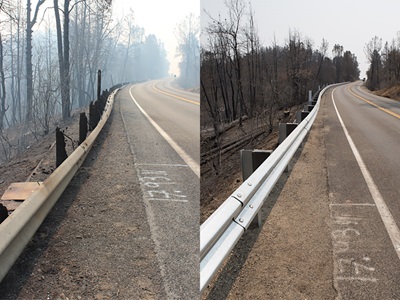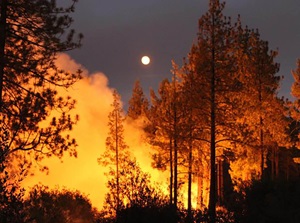Caltrans has already started repairing miles of guardrail after wildfires ravaged the state this summer. Photo by Headquarters 
This summer, hundreds of Caltrans employees worked 12-to-16-hour shifts for weeks while dozens of fires consumed nearly 1.3 million acres statewide and damaged millions of dollars of infrastructure.
"We used to have one fire each summer," said Rene Garcia, Caltrans' Homeland Security Branch Chief. "Now we are fighting – and helping our partners – with multiple fires."
In each of the fires, Caltrans personnel worked 24 hours a day, staffing road closures and repairing guardrail, removing burned trees and debris, controlling erosion, repairing sensors, fixing drainage, signs, culverts, pavement and even a California Highway Patrol truck scale.
Although the same could be said of last year, this is already turning out to be a fire season like no other. The Mendocino Complex Fire in Colusa, Lake, Glenn and Mendocino counties topped last year's Thomas Fire in Ventura and Santa Barbara counties as the largest fire in California's recorded history. This year's Carr Fire, near Redding, is now the seventh-largest California fire and has claimed seven lives.
In Southern California, Caltrans and emergency personnel have had their hands full with multiple large fires burning at once.
"The fires are just unbelievable this year," said District 8 Chief Public Information Officer Terri Kasinga, speaking on Aug. 7."There were two fires on the Cajon Pass, the Holy Fire just broke out and we're still dealing with the Cranston Fire, so I can't wait to see what today holds."
It is the job of Kasinga and fellow Caltrans public information officers throughout the state to inform the public of changes to California's transportation system. In an emergency, Kasinga said it is hard to stop working – even when exhausted.

The Cranston fire burned more than 13,000 acres in Riverside County. The arson fire was started on State Route 74 and also affected traffic on State Route 243.
Photo by District 8
"In an emergency, we just go and go and go," Kasinga said."It's been crazy and tiring. Even when you get home at night, you're still looking at your work phone."
On Aug. 1, Caltrans closed roads due to wildfires in five districts (1, 2, 3, 8 and 10). State Routes 175, 20, 29, 162, 299, 49, 74, 243 and 140 were closed at one point due to fires, or subsequent mudslides from summer rains on burn scars.
Mendocino-area Public Information Officer Cori Reed said the Ranch and River Fires, which comprise the Mendocino Complex, started the same day. "No one had any idea they were going to grow this big," she said.
Reed coordinated with Caltrans partners to find clear routes for supplies, residents and busloads of tourists to get where they needed to go, but the job was challenging because vital roads were literally in the path of flames. On the ground, field employees braved highways surrounded by fire to get motorists out of harm's way (read Caltrans Hero story).
Sharing resources and support was a key factor in responding to the fires across the state. Last year, each Caltrans district received one safety van – mobile storehouses stocked with personal protective equipment, including respiratory and heat illness protection, safety glasses and vests, water and food. During the fires, these vans traveled to the front lines to bring supplies to field employees at highway closures, maintenance stations and at wildfire base camps. Even on days when there are no emergencies, Caltrans' safety personnel bring supplies to prevent injuries and illness to field employees. This helps ensure employees are prepared for whatever their job entails – but they proved critical during an emergency.
During the wildfires, Caltrans' safety personnel worked together to fill gaps in staffing or equipment. For example, Caltrans' Los Angeles staff drove their safety van to Caltrans' north coastal district to give aid to employees controlling traffic, cutting trees and repairing the highways near the Mendocino Complex Fire. This collaboration helped contain these dangerous California fires.

During wildfires, Caltrans employees work at the State Operations Center (SOC) in Mather alongside a representative from every agency that helps control wildfires and aid those displaced by them.
Photo by Headquarters
"We do our best to provide Caltrans employees with everything they need so they are prepared, equipped and ready to respond as best as possible," said Garcia, who worked in the Department Operations Center at Sacramento Headquarters coordinating Caltrans resources statewide.
Caltrans also worked with the California Office of Emergency Services, National Guard and California Highway Patrol around the clock to support firefighters as they worked to extinguish California's wildfires.
Caltrans Emergency Operations Planner Derek Kantar worked 12-hour days for weeks at the State Operations Center in Mather, outside Sacramento, alongside representatives from every agency that helps control wildfires and aid those displaced by them. Kantar helps assess infrastructure damage and develops plans for repair with the Federal Emergency Management Agency, other federal partners, and Cal Fire.
"The relationship Caltrans has with their interagency partners pays wonderful dividends during times of need," Kantar said."We can ask Cal Fire for their assessment on the fire behavior to determine how that might affect Caltrans facilities using various GIS mapping tools and aerial imagery."
Assistant Maintenance Chief Herby Lissade said Caltrans uses technology to assess and restore California's infrastructure following these destructive blazes. Caltrans' Division of Research, Innovation and System Information researches and refines remote sensing techniques to help Caltrans prioritize infrastructure to inspect after natural disasters such as fires, earthquakes or floods. The Department also has taken the lead in creating a Disaster Recovery manual for the World Road Association-PIARC.
"Caltrans embraces and uses technology to protect the traveling public. But as much as we are ahead, there is so much more we can do," said Lissade.

